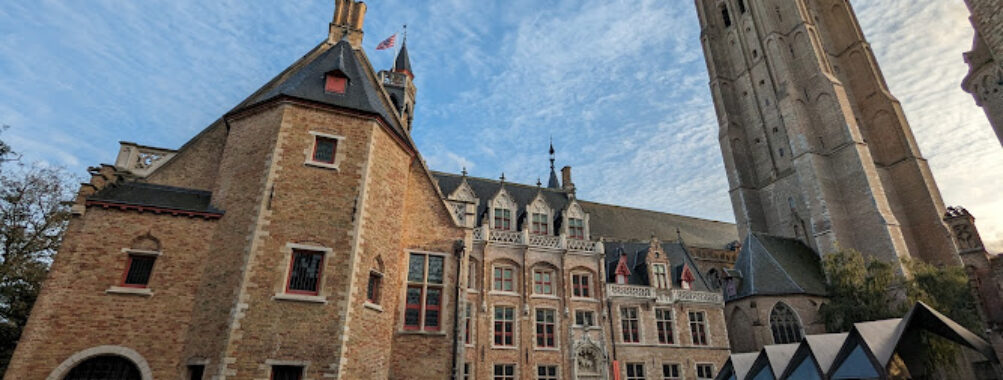
Gruuthusemuseum
“`html
Table of Contents
Description
The Gruuthusemuseum in Bruges is one of those places that quietly sneaks up on you. At first glance, it’s a handsome old city palace, but once you step inside, you realize you’re walking through more than 500 years of history. The building itself was once the lavish home of the wealthy Gruuthuse family, who made their fortune from the trade of “gruut,” a mix of herbs used in brewing beer. Today, the palace has been transformed into a museum that takes visitors on a journey through Bruges’ past, from its Burgundian golden age to its 19th-century revival. It’s not just dusty relics on display either—you’ll find ornate tapestries, delicate lace, stained-glass windows, manuscripts, and even porcelain from faraway lands.
What makes the museum stand out is how it weaves the story of Bruges into its exhibits. Instead of feeling like you’re wandering through random collections, you’re guided through the changing fortunes of the city itself. The audio guide (which I highly recommend using) adds a nice personal touch, giving context to the objects and sometimes even surprising you with little anecdotes. While most visitors leave impressed, some do feel the layout can be a bit confusing or that certain displays are less engaging. But for anyone with a love of history, art, or just a curiosity about how people lived centuries ago, this museum is a rewarding stop. Personally, I found myself lingering longer than expected in the rooms filled with wooden sculptures and intricate tapestries—they’re the kind of details that make you imagine the lives of the people who once walked these halls.
Key Features
- Housed in a former 15th-century city palace with remarkable architecture
- Collections include furniture, tapestries, lace, stained glass, sculptures, manuscripts, and porcelain
- Audio guide available to enrich the experience with stories and context
- Explores three key periods in Bruges’ history: Burgundian era, 17th–18th centuries, and 19th-century neo-Gothic revival
- Family-friendly environment with exhibits that can appeal to children
- LGBTQ+ inclusive and recognized as a safe space for diverse visitors
- Assistive hearing loop available for improved accessibility
- On-site amenities include restrooms and Wi-Fi access
Best Time to Visit
Bruges can be busy with tourists, especially in the summer months, and the Gruuthusemuseum is no exception. If you want to enjoy the museum at a slower pace, mornings during the week are usually the quietest. Spring and autumn are particularly good times to visit Bruges in general—the weather is pleasant, and the crowds are thinner compared to July and August. Winter has its own charm too, especially when the Christmas markets are on; the museum feels extra atmospheric when you step in from the chilly streets. Personally, I went in late September, and it was perfect: fewer people, but still enough buzz in the city to feel lively.
How to Get There
The Gruuthusemuseum is located right in the historic heart of Bruges, so it’s easy to reach on foot if you’re staying in or near the city center. Bruges is a compact city, and most of its attractions are within walking distance of each other. If you’re arriving by train, it’s about a 20-minute walk from the main station to the museum, or you can hop on a local bus to get closer. Driving into Bruges can be tricky due to limited parking, but there is paid street parking available in the area if you need it. Honestly though, I’d recommend leaving the car behind and just strolling through the cobbled streets—it’s part of the experience.
Tips for Visiting
Here are a few things I wish I’d known before visiting, and some that I figured out along the way:
- Use the audio guide: It’s worth it. The objects come alive when you hear the stories behind them, and you’ll notice details you might otherwise miss.
- Plan about 1–2 hours: That’s enough time to explore without rushing, though history buffs may want longer.
- Accessibility is limited: The museum has an assistive hearing loop, but the entrance and parking aren’t wheelchair accessible, so plan ahead if mobility is a concern.
- Bring kids along: The museum is surprisingly good for families. Children often enjoy the grandeur of the palace and the more visual exhibits like stained glass and tapestries.
- Stay connected: There’s Wi-Fi available, which is handy if you like to look things up as you go or share your experience in real time.
- Take breaks: There isn’t a restaurant on-site, so grab a coffee or bite to eat nearby before or after your visit. Bruges has no shortage of cozy cafés just around the corner.
- Check the seasonal events: Sometimes there are temporary exhibitions or cultural events that add another layer to the visit.
One last piece of advice—don’t rush through. It’s tempting to treat museums like checkboxes on a travel list, but the Gruuthusemuseum rewards those who slow down. I remember standing in front of a tapestry for way too long, just marveling at the detail, and realizing that someone centuries ago had poured countless hours into making it. That’s the kind of moment you can’t plan for, but it’s exactly why places like this matter.
“`
Location
Places to Stay Near Gruuthusemuseum
Find and Book a Tour
Explore More Travel Guides
No reviews found! Be the first to review!